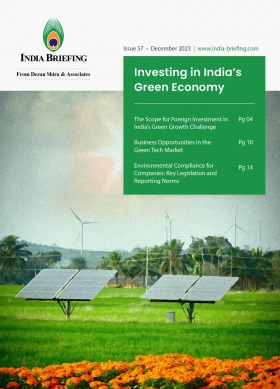India Opens Space Sector to Global Investors with 100% FDI Allowed
India will allow up to 100 percent foreign direct investment (FDI) in its space sector, a move anticipated to attract wider participation of foreign investors, promote technology transfers, and foster applied research and scientific collaboration in this area.
India’s decision to allow 100 percent FDI in its space sector is a strategic move that will lower entry barriers for foreign players seeking to collaborate with or invest in Indian space enterprises.
Previously, FDI in the establishment and operation of satellites was allowed solely through the Government approval route.
However, aligning with the vision and strategy outlined in the Indian Space Policy 2023, the government has liberalized FDI thresholds for various sub-sectors and activities.
FDI rules for the space sector in India
The FDI policy for the space sector categorizes the satellite sub-sector into three activities, each with specified foreign investment limits.
Under the updated policy framework, FDI up to 100 percent via the automatic route will be permitted for the manufacturing of components, systems, or sub-systems associated with satellites, ground segments, and user segments.
- 100 percent FDI allowed: The amended policy permits 100 percent FDI in the space sector, encouraging potential foreign investors to engage with Indian space companies.
- Liberalized entry routes: The policy outlines liberalized entry routes to attract foreign investors to various space activities.
- Up to 74 percent under the automatic route for satellite manufacturing and operation, satellite data products, ground segment, and user segment. Beyond 74 percent, government approval is required.
- Up to 49 percent under the automatic route for launch vehicles, associated systems or subsystems, and creation of spaceports. Beyond 49 percent, government approval will be necessary.
- Up to 100 percent under the automatic route for manufacturing components and systems/sub-systems for satellites, ground segments, and user segments.
- Private sector participation: Increased private sector participation is expected to generate employment, facilitate technology absorption, and promote self-reliance in the sector.
India’s space economy
The recent adjustment to the FDI policy aligns with the objectives of the Indian Space Policy 2023, aimed at enhancing the nation’s capabilities in the space sector through greater participation from the private sector. In December 2023, it was revealed that India was reassessing its FDI policy guidelines for the space industry to promote increased foreign investment.
Per government data from the Department for Promotion of Industry and Internal Trade (DPIIT), the number of space start-ups in India stood at 189 in 2023, a notable growth from just one in 2014. Further, investments in Indian space start-ups have increased to US$124.7 million in 2023.
At present, the Indian space economy is valued at approximately US$8.4 billion, which is roughly 2-3 percent of the global space industry. By 2033, it is anticipated that the country’s space economy will reach US$44 billion, accounting for 8 percent of the entire global space economy.
To accomplish this economic milestone, the private sector will be a necessary stakeholder, taking on extensive responsibilities in the construction of satellites, launch vehicles, satellite services, and ground equipment.
Given that India has an advanced space program, India must move quickly to expand this specialized industry. On August 23, 2023, the Chandrayaan-3 mission made India the first country to land close to the moon’s south pole and the fourth country in the world to successfully execute a moon landing, marking a significant milestone in the country’s recent significant growth in the commercial space sector.
What is India’s space policy?
On April 20, 2023, India unveiled its Indian Space Policy, 2023, which outlines a strategic shift for the Indian Space Research Organization (ISRO), redirecting its focus away from manufacturing operational space systems. Instead, ISRO will concentrate its efforts on advancing research and development in cutting-edge technologies.
The 2023 space policy allows non-government entities (NGEs) to provide both national and international space-based communication services. NGEs can operate their own, procured, or leased satellite systems in geostationary orbit (GSO) and non-geostationary satellite orbit (NGSO), the latter referring to low or medium earth orbits that house satellites offering broadband internet services.
Furthermore, the policy shall promote NGEs to establish and manage ground facilities for space operations, encompassing telemetry, tracking, and command (TT&C) earth stations as well as satellite control centers (SCCs). The policy also endorses the design and development of reusable, recoverable, and reconfigurable technologies and systems for space transportation.
New regulatory body facilitating private sector engagement: IN-SPACe
IN-SPACe or Indian National Space Promotion and Authorization Centre is the single-window, autonomous, nodal agency under the Department of Space. Launched in 2020, it has been established as an independent regulatory body.
Acting as a vital bridge between ISRO and the commercial sector, IN-SPACe takes on the role of overseeing and approving space operations and can be viewed as a part of the structural reform allowing private sector engagement. Its mandate is to encourage the construction of new space facilities and share space infrastructure as well as enabling, authorizing, and supervising a range of private sector space-based undertakings.
So far, IN-SPACe has signed 45 Memorandums of Understanding (MOUs) with non-governmental entities. The MoUs are anticipated to provide the required assistance for the implementation of the space systems and applications that these NGEs envision, which in turn will boost industry involvement in the production of launchers and satellites.
In October 2023, IN-SPACe, in partnership with ISRO and other stakeholders, unveiled a decadal vision and strategy for the Indian space economy, projecting the potential of the country’s space economy to reach US$44 billion by 2033.
Until the early 1990s, India’s space economy and industry were shaped by ISRO, and the only way the private sector was involved was in building to ISRO specifications and plans.
Market outlook
The Indian Space Policy 2023 is designed as a comprehensive and dynamic framework, which serves to realize the country’s potential in the space sector through increased private involvement. This policy aims to enhance space capabilities, foster a robust commercial presence, leverage space for technology development, cultivate international relations, and establish an ecosystem for effective space applications.
Internal stakeholders such as IN-SPACe, ISRO, New Space India Limited (NSIL, ISRO’s commercial wing), and industry partners are working together with the Department of Space. It is anticipated that NGEs, with experience in satellites and launch vehicles, will see increased investment leading to product sophistication, global operations scale, and a larger portion of the global space economy.
The updated FDI policy offers clear guidelines on the permitted investment entry routes and focus areas for greater private sector involvement – satellites, launch vehicles, spaceports, and related components and systems.
India Briefing is produced by Dezan Shira & Associates. The firm assists foreign investors throughout Asia from offices across the world, including in Delhi and Mumbai. Readers may write to india@dezshira.com for more support on doing business in India.
We also maintain offices or have alliance partners assisting foreign investors in Indonesia, Singapore, Vietnam, Philippines, Malaysia, Thailand, Bangladesh, Italy, Germany, Australia, and the United States.
- Previous Article India Notifies ‘Lesser Penalty’ Regime under the Competition Act
- Next Article Establishing a Trading Company in India








